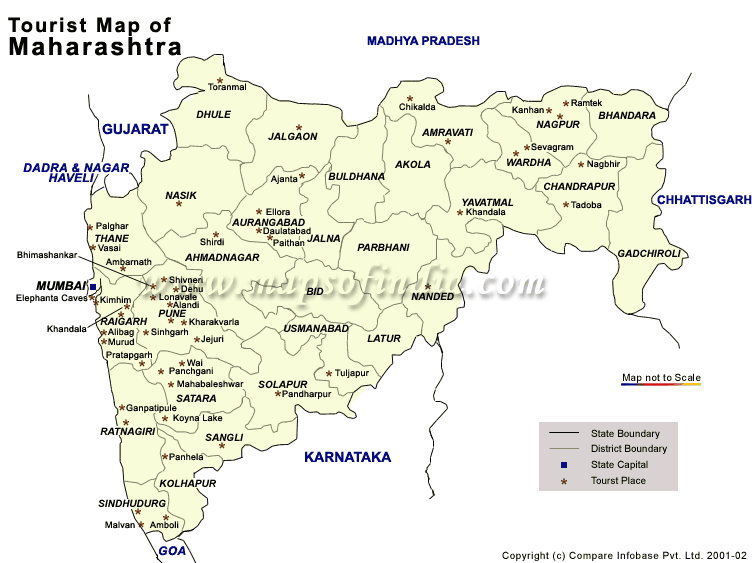Geographical Information Of Maharashtra
*महाराष्ट्रातील प्रमुख ऐतिहासिक किल्ले*
ठाणे - अर्नाळा, वसईचा भुईकोट किल्ला, गोरखगड
रायगड - कर्नाळा, मुरुड-जंजिरा, लिंगाणा, द्रोणागिरी, तळे
रत्नागिरी - सुवर्णदुर्ग (सागरी), रत्नदुर्ग, विजयगड, पासगड
सिंधुदुर्ग - विजयदुर्ग (सागरी), देवगड, पारगड, रामगड
पुणे - शिवनेरी, पुरंदर, प्रचंडगड, सिंहगड, राजगड
नाशिक - ब्रह्मगिरी, साल्हेर-मुल्हेर, मांगी-तुंगी, अंकाई-
औरंगाबाद - देवगिरी (दौलताबाद)
कोल्हापूर - पन्हाळा, विशालगड, भुदरगड
अहमदनगर - हरिश्वंद्रगड, रतनगड
अकोला - नर्नाळा
सातारा - अजिंक्यतारा, मकरंदगड, प्रतापगड, सज्जनगड,
*महाराष्ट्रातील प्रसिद्ध लेण्या व गुंफा मंदिरे*
लेण्या ठिकाण/जिल्हा
अजिंठा, वेरुळ - औरंगाबाद
एलिफंटा, घारापुरी - रायगड
कार्ला, भाजे, मळवली - पुणे
पांडवलेणी - नाशिक
बेडसा, कामशेत - पुणे
पितळखोरा - औरंगाबाद
खारोसा, धाराशीव (जैर) - उस्मानाबाद
*महाराष्ट्रातील प्रमुख जलाशय व धरणे*
जलाशय/नदी स्थळ/जिल्हा
जायकवाडी - बाथसागर (गोदावरी) औरंगाबाद
भंडारदरा - (प्रवरा) अहमदनगर
गंगापूर - (गोदावरी) नाशिक
राधानगरी - (भोगावती) कोल्हापूर
कोयना शिवाजी सागर - (कोयना) हेळवाक (सातारा)
उजनी - (भीमा) सोलापूर
तोतलाडोह - मेघदूत जलाशय (पेंच)- नागपूर
यशवंत धरण - (बोर) वर्धा
मोडकसागर - (वैतरणा) ठाणे
खडकवासला - (मुठा) पुणे
येलदरी - (पूर्णा) परभणी
बाभळी प्रकल्प - (गोदावरी) नांदेड
*महाराष्ट्रातील खनिज संपत्ती व संबंधित जिल्हे*
खनिज जिल्हे
दगडी कोळसा - सावनेर, कामठी, उमरेड (नागपूर), वणी
(यवतमाळ), गुग्गुस, बल्लारपूर (चंद्रपूर)
बॉक्साईट - कोल्हापूर, रत्नागिरी, सिंधुदुर्ग
कच्चे लोखंड - रेड्डी (सिंधुदुर्ग)
मॅग्नीज - सावनेर (नागपूर), तुमसर (भंडारा)
तांबे - चंद्रपूर, नागपूर
चुनखडी - यवतमाळ
डोलोमाईट - रत्नागिरी, यवतमाळ
क्रोमाई - भंडारा, गोंदिया, सिंधुदुर्ग
कायनाईट - देहुगाव (भंडारा)
शिसे व जस्त - नागपूर
*महाराष्ट्रातील प्रमुख औष्णिक वीजनिर्मिती केंद्रे*
औष्णिक केंद ठिकाण/जिल्हा
पारस - अकोला
एकलहरे - नाशिक
कोराडी, खापरखेडा - नागपूर
चोला (कल्याण) - ठाणे
बल्लारपूर - चंद्रपूर
परळीवैजनाथ - बीड
फेकरी (भुसावळ) - जळगाव
तुर्भे (ट्रॉम्बे) - मुंबई
भिरा अवजल (जलविद्युत) - रायगड
कोयना (जलविद्युत) - सातारा
धोपावे - रत्नागिरी
जैतापूर (अणुविद्युत) - रत्नागिरी
*महाराष्ट्रातील प्रमुख लघुउद्योग*
लघुउद्योग ठिकाण
हिमरुशाली - औरंगाबाद
पितांबरी व पैठण्या - येवले (नाशिक)
चादरी - सोलापूर
लाकडाची खेळणी - सावंतवाडी
सुती व रेशमी कापड - नागपूर, अहमदनगर
हातमाग साडय़ा व लुगडी - उचलकरंजी
विडीकाम - सिन्नर (नाशिक), अहमदनगर
काचेच्या वस्तू - तळेगाव, ओगलेवाडी
रेशमी कापड - सावळी व नागभीड (चंद्रपूर),
एकोडी (भंडारा)
*महाराष्ट्रातील प्रमुख विद्यापीठे, स्थापना व ठिकाण*
विद्यापीठ/स्थापना ठिकाण/स्थान
मुंबई विद्यापीठ (१८५७) - मुंबई
पुणे विद्यापीठ (१९४९) - पुणे
राष्ट्रसंत तुकडोजी महाराज नागपूर - नागपूर
विद्यापीठ (१९२५)
कर्मयोगी संत गाडगेबाबा अमरावती - अमरावती
विद्यापीठ (१९८३)
भारतरत्न डॉ. बाबासाहेब आंबेडकर - औरंगाबाद
मराठवाडा विद्यापीठ (१९५८)
शिवाजी विद्यापीठ (१९६३) - कोल्हापूर
यशवंतराव चव्हाण मुक्त विद्यापीठ (१९८८) - नाशिक
महाराष्ट्र आरोग्य विज्ञान विद्यापीठ (१९९८) - नाशिक
डॉ. बाबासाहेब आंबेडकर तंत्रज्ञान - लोणेरे (रायगड)
विद्यापीठ (१९८९)
उत्तर महाराष्ट्र विद्यापीठ (१९८९) - जळगाव
कविकुलगुरू कालिदास संस्कृत - रामटेक (नागपूर)
विद्यापीठ (१९९८)
स्वामी रामानंदतीर्थ मराठवाडा विद्यापीठ (१९९४) - नांदेड
महाराष्ट्र पशू व मत्स्यविज्ञान विद्यापीठ (२०००) - नागपूर
*महाराष्ट्रातील प्रमुख कृषी संशोधन संस्था*
मध्यवर्ती ऊस संशोधन केंद्र, - पाडेगांव (सातारा)
गवत संशोधन केंद्र, - पालघर (ठाणे)
नारळ संशोधन केंद्र, - भाटय़े (रत्नागिरी)
सुपारी संशोधन केंद्र, - श्रीवर्धन (रायगड)
काजू संशोधन केंद्र, - वेंगुर्ला (सिंधुदुर्ग)
केळी संशोधन केंद्र, - यावल (जळगाव)
हळद संशोधन केंद्र, - डिग्रज (सांगली)
राष्ट्रीय डाळिंब संशोधन केंद्र, हिरज - केगांव (सोलापूर)
राष्ट्रीय कांदा- लसून संशोधन केंद्र - राजगुरूनगर (पुणे)
*महाराष्ट्रातील धोर मराठी साहित्यिक व त्यांची टोपण नावे*
 this is physical Map
this is physical Map 







